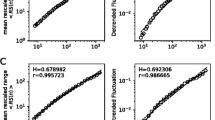Abstract
High variability in the neuronal response to stimulations and the adaptation phenomenon cannot be explained by the standard stochastic leaky integrate-and-fire model. The main reason is that the uncorrelated inputs involved in the model are not realistic. There exists some form of dependency between the inputs, and it can be interpreted as memory effects. In order to include these physiological features in the standard model, we reconsider it with time-dependent coefficients and correlated inputs. Due to its hard mathematical tractability, we perform simulations of it for a wide investigation of its output. A Gauss–Markov process is constructed for approximating its non-Markovian dynamics. The first passage time probability density of such a process can be numerically evaluated, and it can be used to fit the histograms of simulated firing times. Some estimates of the moments of firing times are also provided. The effect of the correlation time of the inputs on firing densities and on firing rates is shown. An exponential probability density of the first firing time is estimated for low values of input current and high values of correlation time. For comparison, a simulation-based investigation is also carried out for a fractional stochastic model that allows to preserve the memory of the time evolution of the neuronal membrane potential. In this case, the memory parameter that affects the firing activity is the fractional derivative order. In both models an adaptation level of spike frequency is attained, even if along different modalities. Comparisons and discussion of the obtained results are provided.














Similar content being viewed by others
References
Abundo M (2013) On the representation of an integrated Gauss–Markov process. SCMJ e–2013:719–723
Abundo M (2015) On the first passage time of an integrated Gauss–Markov process. SCMJ 28:1–14
Armanyos M, Radwan AG (2016) Fractional-order Fitzhugh–Nagumo and Izhikevich neuron models. 2016 13th international conference on electrical engineering/electronics, computer, telecommunications and information technology (ECTI-CON), pp 1–5
Ascione G, Pirozzi E On fractional stochastic modeling of neuronal activity including memory effects, LNCS (submitted)
Bazzani A, Bassi G, Turchetti G (2003) Diffusion and memory effects for stochastic processes and fractional Langevin equations. Phys A Stat Mech Appl 324(3):530–550. doi:10.1016/S0378-4371(03)00073-6 ISSN 0378-4371
Bernido CC, Carpio-Bernico MV (2012) On a fractional stochastic path integral approach in modelling interneuronal connectivity. Int J Mod Phys Conf Ser 17:23–33
Biagini F, Hu Y, Oksendal B, Zhang T (2008) Stochastic calculus for fractional Brownian motion and applications. Springer, Berlin
Buonocore A, Caputo L, Pirozzi E, Ricciardi LM, Buonocore A, Caputo L, Pirozzi E, Ricciardi LM (2010) On a stochastic leaky integrate-and-fire neuronal model. Neural Comput 22:2558–2585
Buonocore A, Caputo L, Pirozzi E, Ricciardi LM (2011) The first passage time problem for gauss-diffusion processes: algorithmic approaches and applications to LIF neuronal model. Methodol Comput Appl Probab 13:29–57
Buonocore A, Caputo L, Nobile AG, Pirozzi E (2015) Restricted Ornstein–Uhlenbeck process and applications in neuronal models with periodic input signals. J Comput Appl Math 285:59–71
Buonocore A, Caputo L, Carfora MF, Pirozzi E (2016) A leaky integrate-and-fire model with adaptation for the generation of a spike train. Math Biosci Eng 13(3):483–493
Burkitt AN (2006) A review of the integrate-and-fire neuron model: I. Homogeneous synaptic input. Biol Cybern 95:119
Di Nardo E, Nobile AG, Pirozzi E, Ricciardi LM (2001) A computational approach to first passage-time problems for Gauss–Markov processes. Adv Appl Probab 33:453–482
D’Onofrio G, Pirozzi E (2016) Successive spike times predicted by a stochastic neuronal model with a variable input signal. Math Biosci Eng 13(3):495–507. doi:10.3934/mbe.2016003
Kumar RU, Mondal A (2015) Dynamics of fractional order modified Morris–Lecar neural model. Netw Biol 5(3):113–136
Kim H, Shinomoto S (2014) Estimating nonstationary inputs from a single spike train based on a neuron model with adaptation. Math Bios Eng 11:49–62
Kobayashi R, Tsubo Y, Shinomoto S (2009) Made-to-order spiking neuron model equipped with a multi-timescale adaptive threshold. Front Comput Neurosci 3:9
Nobile AG, Pirozzi E, Ricciardi LM (2008) Asymptotics and evaluations of FPT densities through varying boundaries for Gauss–Markov processes. Sci Math Jpn 67(2):241–266
Ostojic S (2011) Interspike interval distributions of spiking neurons driven by fluctuating inputs. J Neurophysiol 106:361–373
Pedjeu J, Ladde GS (2012) Stochastic fractional differential equations: modeling, method and analysis. Chaos Solitons Fractals 45:279–293
Podlubny I (1999) Fractional differential equations. Academic Press, London
Sacerdote L, Giraudo MT (2012) Stochastic integrate and fire models: a review on mathematical methods and their applications. In: Stochastic Biomathematical Models, Volume 2058 of Lecture Notes in Mathematics, pp 99–148
Shinomoto S, Sakai Y, Funahashi S (1997) The Ornstein–Uhlenbeck process does not reproduce spiking statistics of cortical neurons. Neural Comput 11:935–951
Sakai Y, Funahashi S, Shinomoto S (1999) Temporally correlated inputs to leaky integrate-and-fire models can reproduce spiking statistics of cortical neurons. Neural Netw 12:1181–1190
Stevens CF, Zador AM (1998) Input synchrony and the irregular firing of cortical neurons. Nat Neurosci 1:210–217
Teka W, Marinov TM, Santamaria F (2014) Neuronal spike timing adaptation described with a fractional leaky integrate-and-fire model. PLoS Comput Biol 10(3):e1003526
Teka WW et al (2017) Fractional-order leaky integrate-and-fire model with long term memory and power law dynamics. Neural Netw 93:110–125. doi:10.1016/j.neunet.2017.05.007
Tuckwell H (1988) Introduction to theoretical neurobiology. Cambridge University Press, Cambridge
Acknowledgements
This work was partially supported by Gruppo Nazionale per il Calcolo Scientifico (GNCS-INdAM). I acknowledge the constructive criticism of anonymous reviewers on an earlier version of this paper. I extend my thanks to Maria Francesca Carfora for the initial support and her kind assistance to improve some sentences of the manuscript. I am particularly grateful for fruitful and stimulating discussions and the generous assistance given by Giacomo Ascione during the development of this research work.
Author information
Authors and Affiliations
Corresponding author
Additional information
This article belongs to a Special Issue on Neural Coding.
Rights and permissions
About this article
Cite this article
Pirozzi, E. Colored noise and a stochastic fractional model for correlated inputs and adaptation in neuronal firing. Biol Cybern 112, 25–39 (2018). https://doi.org/10.1007/s00422-017-0731-0
Received:
Accepted:
Published:
Issue Date:
DOI: https://doi.org/10.1007/s00422-017-0731-0




